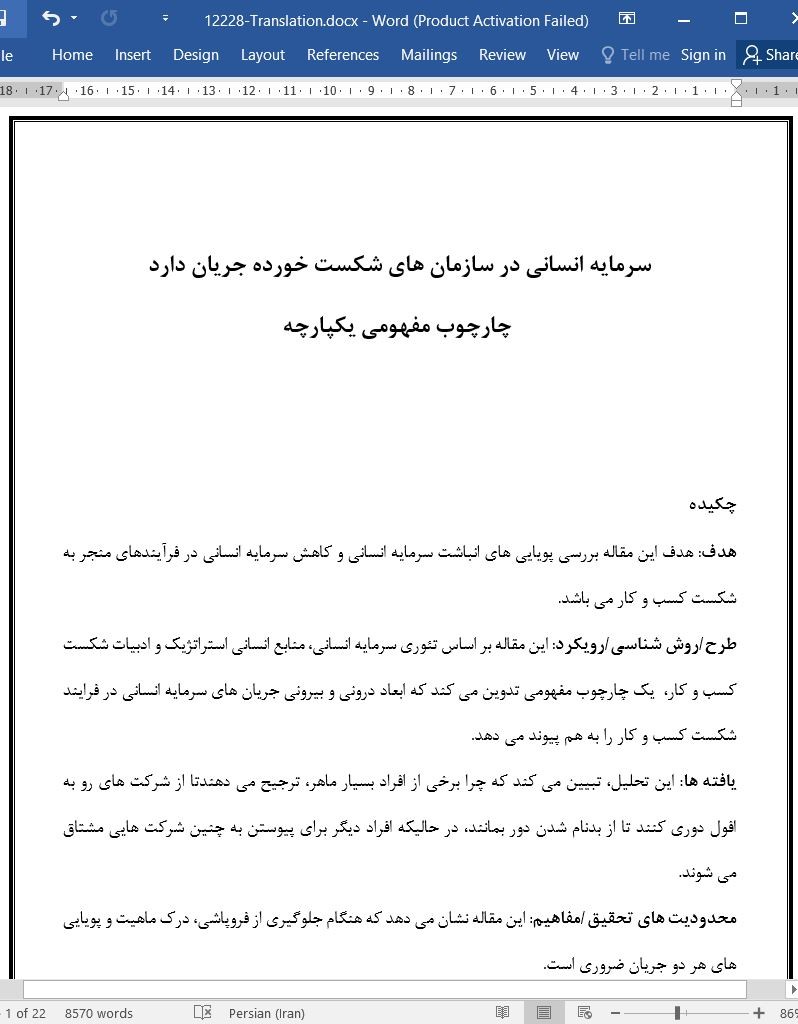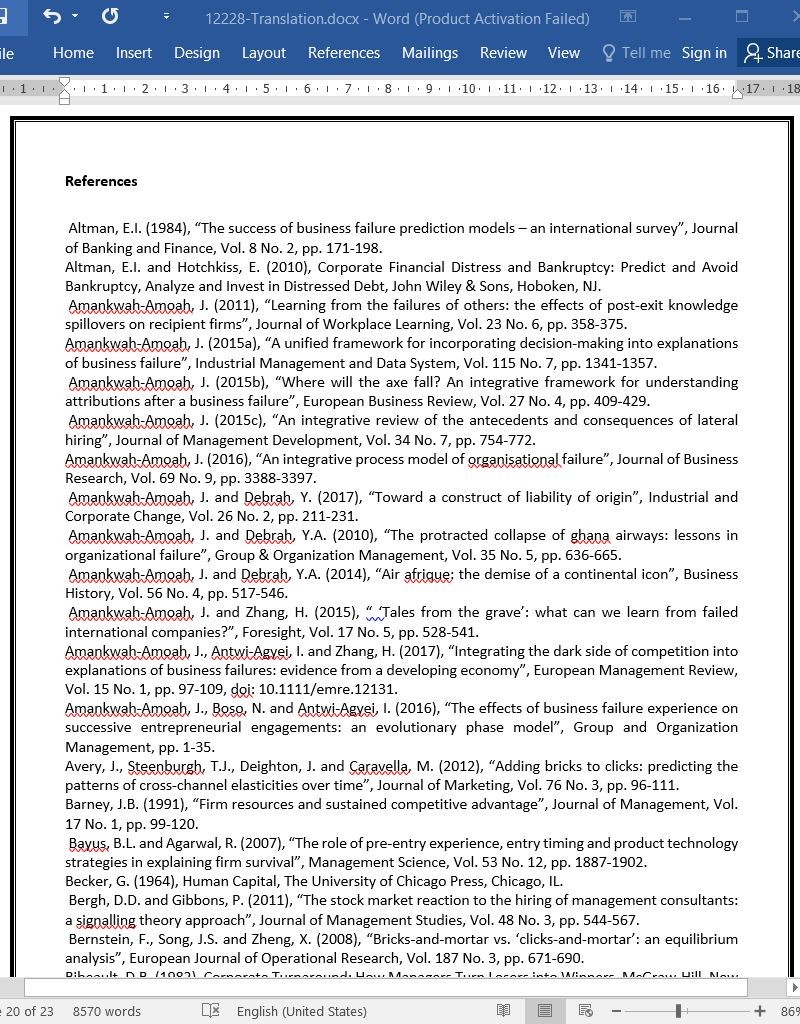
سرمایه انسانی در سازمان های شکست خورده جریان دارد
چکیده
هدف: هدف این مقاله بررسی پویایی های انباشت سرمایه انسانی و کاهش سرمایه انسانی در فرآیندهای منجر به شکست کسب و کار می باشد.
طرح/روش شناسی/رویکرد: این مقاله بر اساس تئوری سرمایه انسانی، منابع انسانی استراتژیک و ادبیات شکست کسب و کار، یک چارچوب مفهومی تدوین می کند که ابعاد درونی و بیرونی جریان های سرمایه انسانی در فرایند شکست کسب و کار را به هم پیوند می دهد.
یافته ها: این تحلیل، تبیین می کند که چرا برخی از افراد بسیار ماهر، ترجیح می دهندتا از شرکت های رو به افول دوری کنند تا از بدنام شدن دور بمانند، در حالیکه افراد دیگر برای پیوستن به چنین شرکت هایی مشتاق می شوند.
محدودیت های تحقیق/مفاهیم: این مقاله نشان می دهد که هنگام جلوگیری از فروپاشی، درک ماهیت و پویایی های هر دو جریان ضروری است.
نوآوری و ارزش: علیرغم وجود مجموعه ی زیادی از تحقیقات در زمینه شکست کسب و کار و رقابت شدید بر سر استعدادهای برتر، بسیاری از ادبیات موجود، رابطه ی بین آنها را نادیده گرفته است. این مطالعه، یک مدل یکپارچه تدوین می کند که درک ما از جریان های سرمایه انسانی را افزایش می دهد.
مقدمه
در چند دهه گذشته، جریان گسترده ای از تحقیق نشان داده است که وقتی شرکتها در حال سقوط هستند یا عملکرد رو به افول را تجربه می کنند، برخی افراد بسیار ماهر برای جلوگیری از بدنام شدن و متحجر شدن، شرکت را ترک می کنند(جیانگ و همکاران، 2017؛ سمادنی و همکاران، 2008؛ ساتون و کالاهان،1987؛ پوزنر، 2008). در واقع، خطر شکست کسب و کار یک تاثیر احساسی و روانی دارد، که قبل یا بعد از سقوط بر جابجایی کارکنان تاثیر می گذارد(رجوع کنید به شفرد،2003). با توجه به اینکه اعضای تیم مدیریت عالی با ورشکست شدن، دچار بدنامی می شوند، منطقی است که برخی آنها شرکت را ترک کنند(ویزنفلدت و همکاران،2008). با این حال، ممکن است یک طرف دیگر از سکه هم وجود داشته باشد، که در آن برخی افراد با مهارت بالا و سازمان های معتبر تصمیم می گیرند، وارد چنین سازمانهای ورشکسته ای شوند. در واقع، انباشت سرمایه انسانی می تواند نقش موثری در تغییر فرآیند افول کسب و کار داشته باشد(رجوع کنید به دی آوانی، 1990). با این حال، زمینه های نظری که در ان جریان های آثار علمی جدید مجددا تدوین و بررسی شده است، باید به طور کامل هر دو بعد جریان سرمایه انسانی را درست قبل از سقوط کسب و کار، درک و بررسی کند.
Abstract
Purpose The purpose of this paper is to examine the dynamics of human capital accumulation and human capital depletion in the processes leading to business failure.
Design/methodology/approach Building on the human capital theory, strategic human resource and business failure literature, this paper develops a conceptual framework which links the inward and outward dimensions of human capital flows in the business failure process. Findings The analysis sheds light on why some highly skilled individuals may opt to flee declining firms to avoid being stigmatised whilst others become motivated to joint such firms.
Research limitations/implications The paper suggests that understanding the nature and dynamics of both flows are essential when seeking to avert collapse.
Originality/value In spite of a growing body of research on business failure and intense competition for top talent, much of the existing literature has circumvented the relationship between them. This study develops a unified model towards enhancing our understanding of the human capital flows.
Introduction
Over the past couple of decades, a burgeoning stream of research has demonstrated that when companies are collapsing or experiencing declining performance, some highly skilled individuals jump ship to avoid being stigmatised and stereotyped ( Jiang et al., 2017; Semadeni et al., 2008; Sutton and Callahan, 1987; Pozner, 2008). Indeed, threat of business failure has an emotional and psychological effect which then influences employees’ mobility just before or after the collapse (see Shepherd, 2003). Given that top-management team members are often stigmatised by failure, it makes sense for some to jump ship (Wiesenfeld et al., 2008). Nevertheless, there might be another side of the coin where some highly skilled individuals and reputable organisations decide to get “on board” such failing firms. Indeed, human capital accumulation can play a pivotal role in reversing the business decline process (see D’Aveni, 1990). Yet the theoretical grounds on which the current streams of scholarly works have been reformulated and examined have yet to fully embrace and explore both dimensions of human capital flows just before business collapse
چکیده
مقدمه
شکست کسب و کار: مرور و بازبینی کلی
بررسی و مرور کلی: سرمایه انسانی
فرآیند شکست کسب و کار: جریان درونی و بیرونی سرمایه انسانی
کاهش سرمایه انسانی(جریان بیرونی)
انباشت سرمایه انسانی(جریان درونی)
تعامل جریان درونی و بیرونی
بحث و نتیجه گیری
کمک به تئوری و عمل
محدودیت ها و رهنمود هایی برای پژوهش های بعدی
منابع
Abstract
Introduction
Business failure: a review and overview
Human capital: a review and overview
Business failure process: inward and outward flow of human capital
Human capital depletion (outflow)
Human capital accumulation (inflow)
Inward–outward interactions
Discussion and conclusions
Contributions to theory and practice
Limitations and directions for further research
References
- اصل مقاله انگلیسی با فرمت ورد (word) با قابلیت ویرایش
- ترجمه فارسی مقاله با فرمت ورد (word) با قابلیت ویرایش، بدون آرم سایت ای ترجمه
- ترجمه فارسی مقاله با فرمت pdf، بدون آرم سایت ای ترجمه



